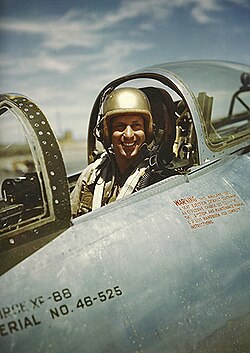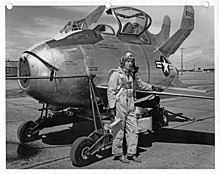Edwin Foresman Schoch
Lieutenant Edwin Foresman Schoch | |
|---|---|
 Edwin Foresman Schoch in the XF-88 Voodoo at Edwards AFB | |
| Birth name | Edwin Foresman Schoch |
| Nickname(s) | Ed |
| Born | September 13, 1916 Oakmont, Pennsylvania, U.S. |
| Died | September 13, 1951 (aged 35) Elsberry, Missouri, U.S. |
| Allegiance | |
| Service | |
| Years of service | 1941–45 (4 years) |
| Rank | Lieutenant |
| Battles / wars | |
| Awards | See below |
| Spouse(s) | Arlene Whelply Schoch Judy (1920–2009) |
| Children | 4 |
| Other work | Test pilot |
Edwin Foresman Schoch (September 13, 1916 – September 13, 1951) was a United States Navy aeronautical engineer, combat pilot and test pilot.
As a lieutenant in the Naval Reserve, he flew in combat against Japanese forces in the Pacific. After the war's end, he became one of the most renowned test pilots at McDonnell Aircraft Corporation and test-flew several experimental and early-model jet fighters including the XF-85 Goblin.[1]
Early years
[edit]Born in Oakmont, Pennsylvania, in 1916 to a family in the railroad industry that moved several times as he was growing up, Schoch graduated from South Park High School in Buffalo, New York. He worked for several years as a railroad clerk, saving money during the Great Depression so that he could attend college. He enrolled in Virginia Polytechnic Institute (VPI) in Blacksburg, Virginia, and graduated with a degree in mechanical engineering and a second lieutenant's commission in the United States Army.[2]
Having learned to fly at VPI through the Reserve Officers' Training Corps (ROTC) program, he wanted to fly fighter aircraft. He thought his chances of being able to do so were better in the Navy than in the Army so, upon graduation in spring 1941, he resigned his Army commission, enrolled in the Navy Reserve as a seaman 2nd class and, having already learned to fly in VPI's ROTC program, was quickly accepted into the Navy’s flight training program.[2]

World War II
[edit]Once he had earned his pilot's wings in the Navy, Schoch was assigned to Fighting Squadron 19, then being formed for anticipated combat against the Japanese in the Pacific as part of Air Group 19. With his engineering degree, Schoch was designated as the squadron engineering officer, and flew 46 combat missions with the squadron from the USS Lexington (CV-16) in summer and fall 1944.[2]
Flying the Grumman F6F Hellcat, he shot down four Japanese aircraft during the squadron's combat tour, and hit a Japanese aircraft carrier with a bomb during the Battle of Leyte Gulf.[3]

After his combat tour, in January 1945, Schoch was assigned to Fighter-Bomber Squadron 150, which was being formed in the United States in preparation for an invasion of Japan in 1945. He began training, once again as the engineering officer, in the new Vought F4U-4 at bases on the east coast of the US and aboard the newly commissioned USS Lake Champlain (CV-39).[4] Japan’s surrender made both the invasion and Fighter-Bomber Squadron 150 unnecessary.[5]
The war ended before either the squadron or the aircraft carrier saw combat duty, and Schoch left the Navy in November 1945.[2]
McDonnell career
[edit]Schoch was hired immediately after the war by McDonnell Aircraft Corporation as an aeronautical engineer and quickly moved up to a test pilot position as the company grew.[6] He was the tenth pilot to fly the company’s FH-1 Phantom,[7] the U.S. Navy’s first jet fighter to be carrier-qualified. He was the second pilot to fly the F2H Banshee, the Phantom's successor. The Phantom never saw combat service, but the Banshee was widely used during the Korean War (1950–1953) as a reconnaissance aircraft.[8]
Schoch was the only pilot to fly the company’s XF-85 Goblin, at what is now Edwards Air Force Base.[9][10] The Goblin was an experimental "parasite" fighter contemplated for use by the US Air Force in conjunction with the B-36 bomber.[11] With the giant bomber still unavailable at the inception of the test program, for the test phase the special "trapeze"[12] needed to launch and recover the small fighter was fitted on a Boeing EB-29.[13][14]

Flying the Goblin required skill,[15] due to the difficulty of the hook-up manoeuvre and the lack of proper landing gear if hook up was not completed. In seven free flights[16] only the second, third and fourth resulted in successful hook-ups with the EB-29 mother ship,[17] while the remaining four were concluded by belly-landings on the special landing skid of the parasite.[18][19]
Schoch was also one of the lead pilots for McDonnell’s XF-88 program.[20][21]
Both the XF-85 and the XF-88 programs were cancelled in the early 1950s, but the XF-88 showed enough promise to be revived a few years later and, with some modification, eventually became the F-101 Voodoo.[22]
In between McDonnell’s experimental test programs at Edwards Air Force Base,[23] Schoch flew numerous routine and maintenance test flights for aircraft already in production at the company's St. Louis facility.[24]
Furthermore, while in service at the Naval Air Test Center in January 1948 he flew the North American FJ-1 Fury.[25]
Death and honors
[edit]While making a test flight over rural Missouri on his 35th birthday to investigate elevator-related issues, metal fatigue caused the tail section of the F2H-2 he was flying to fail, and then come apart in the air. He was killed in the ensuing crash.[26]

The sequence of events is unclear, as the few witnesses were a mile or more away[27] and there were no flight data recorders in use at that time. The crash site is about 60 miles (97 km) northwest of St. Louis.[28]

| Air Medal – for his service during Fighting Squadron 19’s combat tour of duty, largely incorporating the Philippine campaign. | |
| Distinguished Flying Cross – for shooting down three Japanese fighter planes in a single day, October 24, 1944, during the Battle of Leyte Gulf.[29] | |
| Navy Cross – for placing a semi-armor-piercing bomb aboard the Japanese light carrier Zuiho on October 25, 1944, helping to sink that ship during the Battle of Leyte Gulf.[30] | |
| Conspicuous Service Cross (New York) – awarded in December 2020 by the Governor of the State of New York for his service during World War II, upon initiative by South Park High School. |
References
[edit]- ^ Pace, Steve (1991). X-Fighters: USAF Experimental and Prototype Fighters, XP-59 to YF-23. St. Paul, Minnesota: Motorbooks International. ISBN 0-87938-540-5.
- ^ a b c d Schoch, Ray (2014). An Aviator: The Aerial Career of Edwin Foresman Schoch. San Francisco, California: Blurb Publishing Service. pp. 1–252.
- ^ Williams, Bruce W. (1945). History of Fighting Squadron Nineteen, 15 August 1943 to 14 December 1944. Washington, D.C.: The History Unit, Op-33-J-6, Office of the Chief of Naval Operations.
- ^ Radford, C. S. Jr. (1945). History of Bomber Fighting Squadron One Hundred Fifty from 22 January 1945 to February 28, 1945, Inclusive. Washington, D.C.: Naval Aviation History Unit, Op-33-J-6, Office of Editorial Research.
- ^ Radford, C. S. Jr. (1945). History of Bomber Fighting Squadron One Hundred Fifty from 30 June 1945 to 1 November 1945, Inclusive. Washington, D.C.: Naval Aviation History Unit, Op-33-J-6, Office of Editorial Research.
- ^ "Biggest thrill of the Navy show". McDonnell Aircraft Corporation Airscoop. Vol. VI, no. 18. St. Louis, Mo. November 1, 1946.
- ^ "M.A.C. Test Pilots Steal The Show". McDonnell Aircraft Corporation Airscoop. Vol. VIII, no. 7. St. Louis, Mo. July 1949.
- ^ Ginter, Steve (2006). Naval Fighters Number Seventy-Three: Early Banshees' – The McDonnell F2H-1, F2H-2/2B/2N/2P. Simi Valley, CA: Steve Ginter. ISBN 0-942612-73-6.
- ^ Evangelisti, Giorgio (1980). Macchine bizzarre nella storia dell'aviazione. Firenze, Italy: Editoriale Olimpia. pp. 227–232.
- ^ Winchester, Jim (2005). McDonnell XF-85 Goblin in Concept Aircraft: Prototypes, X-Planes and Experimental Aircraft. San Diego, California: Thunder Bay Press. ISBN 1-59223-480-1.
- ^ Dorr, Robert F. (1997). "Beyond the frontiers: McDonnell XF-85 Goblin: The built-in fighter". Wings of Fame. 7.
- ^ Smith, Richard K. (December 1967). "An Escort Appended... The Story of the McDonnell XF-85 Goblin". Flying Review International. 22 (16).
- ^ Size Knaack, Marcelle (1978). Encyclopedia of US Air Force Aircraft and Missile Systems: Post-World War II Fighters 1945–1973. Vol. 1. Washington, DC: Office of Air Force History. ISBN 0-912799-59-5.
- ^ Fitzsimons, Bernard, ed. (1978). The Illustrated Encyclopedia of 20th Century Weapons and Warfare. Vol. 5. London: Phoebus. ISBN 978-0-8393-6175-6.
- ^ Cowin, Hugh W. (June 2011). "McDonnell's unmanageable Goblin". Aviation News.
- ^ "August 23, 1948: XF-85 Goblin Aircraft debuts". Retrieved December 4, 2020.
- ^ Powers, Richard D (1973). "Monstro and the Goblins". American Aviation Historical Society Journal. 18: 146–159. Archived from the original on December 9, 2020. Retrieved November 28, 2020.
- ^ Sundey, Terry L. (January 1985). "Built-in Escort: The story of McDonnell's XF-85 'Goblin' parasite fighter". Airpower. 15 (1).
- ^ Gunston, Bill (1981). McDonnell XF-85 Goblin. United States, North Branch MN: Specialty Press. ISBN 0-933424-32-9.
- ^ Jenkins, Dennis R.; Landis, Tony R. (2008). Experimental and Prototype U.S. Air Force Jet Fighters. United States, North Branch MN: Specialty Press. pp. 80–85. ISBN 978-1-58007-111-6.
- ^ "XF-88 Evaluation Completed at Muroc". McDonnell Aircraft Corporation Airscoop. Vol. IX, no. 8. St. Louis, Mo. August 1950.
- ^ Peacock, Lindsay. "The One-O-Wonder", Air International, Volume 29, No. 2, August 1985, pp. 75–81, 93–95. ISSN 0306-5634
- ^ "Department of Desert Warfare – Muroc Air Force Base Operations". McDonnell Aircraft Corporation Airscoop. Vol. VII, no. 7. St. Louis, Mo. August 1948.
- ^ "M.A.C. Group At Institute of Aeronautical Science Meeting In Los Angeles". McDonnell Aircraft Corporation Airscoop. Vol. VII, no. 8. St. Louis, Mo. September 1948.
- ^ Grossnick, Roy A. (1997). United States Naval Aviation 1910–1995, Appendix 30 – List of Early Naval Jet Pilots. Washington, D.C.: Naval Historical Center. ISBN 978-0160491245.
- ^ "Edwin F. Schoch 1916–1951". McDonnell Aircraft Corporation Airscoop. Vol. X, no. 10. St. Louis, Mo. October 1951.
- ^ "Navy Banshee Crashes, Burns". The La Crosse Tribune. La Crosse, Wisconsin. September 14, 1951. Retrieved December 4, 2020.
- ^ "Another McDonnell Jet Pilot Killed in Test". St. Louis Globe – Democrat. St. Louis, Mo. September 14, 1951.
- ^ "VBF-150 Squadron History - 22 January 1945 to 28 February 1945 inclusive - Part III - Appendices - Thumb-Nail biographies of Squadron Commanding Officers and outstanding personalities". United States Navy. Retrieved December 4, 2020.
- ^ "Edwin Foresman Schoch". Retrieved December 4, 2020.
External links
[edit]- 1916 births
- 1951 deaths
- Accidental deaths in Missouri
- American test pilots
- American aerospace engineers
- Aviators killed in aviation accidents or incidents in the United States
- Military personnel from Pennsylvania
- People from Oakmont, Pennsylvania
- United States Navy officers
- United States Navy pilots of World War II
- Victims of aviation accidents or incidents in 1951
- Victims of flight test accidents
- Virginia Tech alumni
